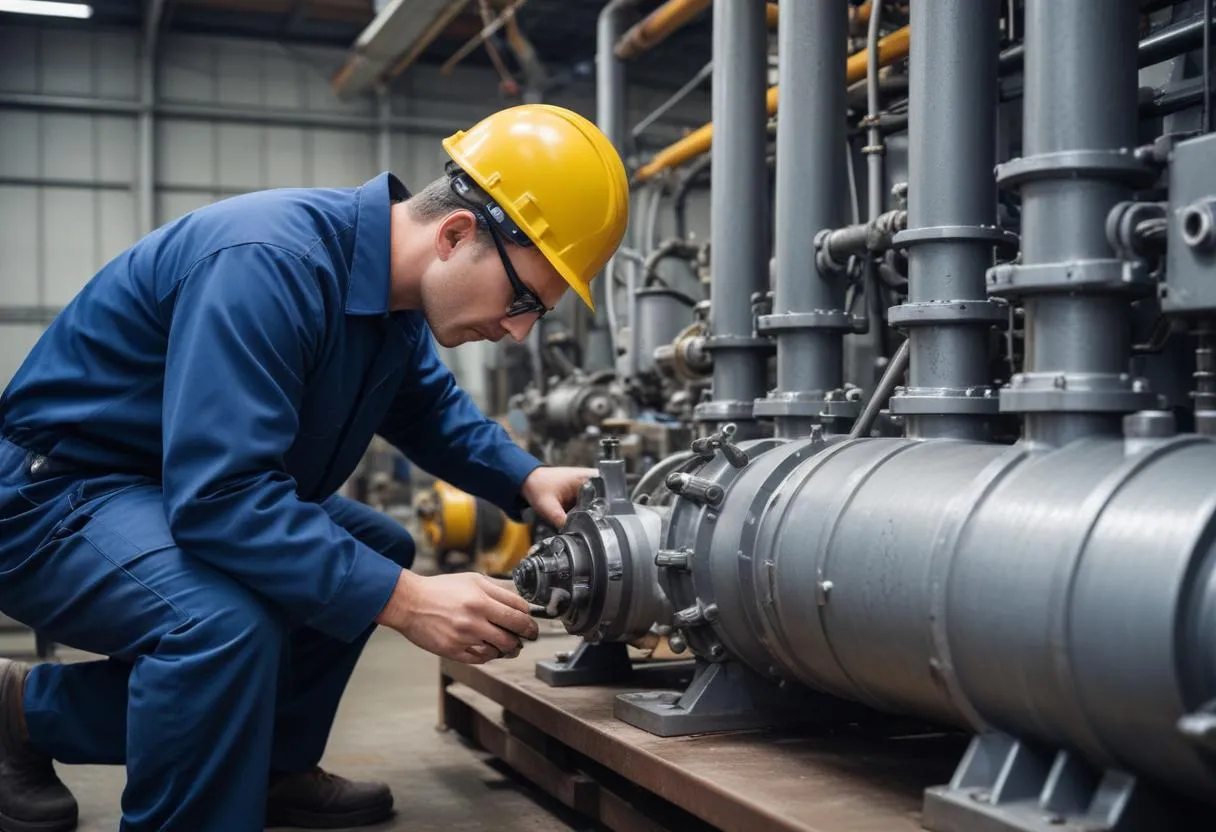 Pumps come in a variety of types, each designed to meet specific needs in a wide array of industries. The choice of the right pump depends largely on its intended use, the nature of the fluid to be moved, and the environment in which it will operate.
Pumps come in a variety of types, each designed to meet specific needs in a wide array of industries. The choice of the right pump depends largely on its intended use, the nature of the fluid to be moved, and the environment in which it will operate.
Centrifugal Pumps are the most common pump type used today due to their versatility. They are suitable for both thin liquids like water and thicker liquids like sewage. Centrifugal pumps operate using a rotating impeller which creates a vacuum, forcing liquid to move. They are often used in buildings for water supply, in industries for processing tasks, and in water treatment plants.
Positive Displacement Pumps offer a different mechanism through the use of rotating or reciprocating parts to directly push liquid in an enclosed volume until it is forced out into a discharge pipe. This type is ideal for dealing with viscous liquids or liquids containing suspended solids. Positive displacement pumps are widely used in the food, dairy, and cosmetics industries as they handle shear-sensitive liquids effectively.
Diaphragm Pumps, a sub-category of positive displacement pumps, use a diaphragm that moves back and forth to change the volume of the pumping chamber. This pump is particularly useful for applications requiring a seal between the drive mechanism and the liquid, making it a good choice for hazardous or toxic fluids.
Submersible Pumps are designed to be submerged in the liquid they are pumping. They are typically used in deep water applications like well drilling, pond filtering, and sewage pumping. These pumps are highly efficient because they don’t rely on external air pressure to drive fluid.
| Type of Pump | Applications | Key Benefits |
|---|---|---|
| Centrifugal | Water treatment, Building water supply, Industrial processes | Versatility with liquids, Efficient operation |
| Positive Displacement | Food processing, Dairy, Cosmetics | Handles viscous liquids, Minimizes shear |
| Diaphragm | Chemical handling, Hazardous fluids | Secure sealing, Handles toxic materials |
| Submersible | Well drilling, Sewage pumping, Pond filtering | Can operate submerged, No reliance on external pressure |
- Centrifugal pumps are excellent for large volume needs where fluid viscosity is low.
- Positive displacement pumps are chosen for precise volume control and handling complex materials.
- Diaphragm pumps excel in pumping hazardous fluids with requirements for high levels of hygiene and safety.
- Submersible pumps are the best option in scenarios where the pump needs to operate under water.
Selecting the right type of pump for a specific application is critical for operational success and efficiency. Understanding each type’s distinct characteristics helps in identifying which pump would be best suited for the demands of the task.
Key factors to consider when choosing a pump
When choosing a pump for a specific application, several key factors should be considered to ensure operational efficiency and durability. Here we explore these essential considerations in detail.
Flow Rate is perhaps the most crucial aspect to consider. The flow rate refers to how much liquid the pump can move per unit of time and is usually measured in gallons per minute (GPM) or liters per minute (LPM). Calculating the necessary flow rate for your operation helps in selecting a pump that can handle the demand without overloading. It’s essential to estimate the required flow rate with a margin for potential increases in demand to avoid frequent upgrades.
Total Dynamic Head (TDH) is another vital metric which combines the static lift, the friction losses in the piping, and any pressure requirements of the system. It’s essential to understand the height the pump needs to move the liquid and any resistance it will encounter through the system to select a pump that can operate efficiently at these conditions.
Viscosity of the Fluid also plays a critical role in pump selection. Thicker fluids require more energy to move, and certain pump types, like positive displacement pumps, are better suited for these conditions. On the other hand, centrifugal pumps might be preferable for lower-viscosity fluids.
Chemical Compatibility is crucial when the fluids being pumped are corrosive or contain particulates. The materials used in the construction of the pump should be compatible with the fluid to avoid degradation and potential failure. Compatibility charts are available from pump manufacturers to aid in selecting the right materials for the internals and casings of the pump.
Power Source is another factor that can influence the choice of pump. Depending on the availability of electricity, pneumatic or hydraulic options might be necessary. Furthermore, the cost of energy to operate the pump should be considered as this can significantly affect the overall operating costs.
Environment in which the pump will operate cannot be overlooked. For pumps operating in explosive atmospheres, special certifications like ATEX may be needed for safety. Similarly, submersible pumps are specifically designed for underwater operations, making them perfect for pumping from wells, ponds, or pits.
| Factor | Description | Importance |
|---|---|---|
| Flow Rate | Volume of fluid moved per unit time | Crucial for meeting system demands |
| Total Dynamic Head | Total resistance the pump needs to overcome | Essential for efficiency in fluid movement |
| Viscosity | Thickness of the fluid | Impacts the type of pump needed |
| Chemical Compatibility | Material resistance to the fluid | Key to pump longevity and safety |
| Power Source | Type of energy available | Affects operational practicality and cost |
| Environment | Location and conditions of operation | Dictates special requirements or certifications |
In summary, selecting the right pump involves a deep understanding not just of the pump’s characteristics but how these characteristics align with the demands of the application. Proper assessment and consideration of the outlined factors ensure that the selected pump performs optimally, leads to longer equipment life, and reduces the risk of failure and maintenance problems.
Maintenance and efficiency considerations
 Maintenance and efficiency are pivotal aspects to consider when managing the lifecycle and operational costs of pumps. Strategic maintenance planning and optimizing pump efficiency not only prolong the useful life of the equipment but also significantly reduce energy consumption, which can account for a substantial part of the operating budget.
Maintenance and efficiency are pivotal aspects to consider when managing the lifecycle and operational costs of pumps. Strategic maintenance planning and optimizing pump efficiency not only prolong the useful life of the equipment but also significantly reduce energy consumption, which can account for a substantial part of the operating budget.
### Regular Maintenance Schedule
To ensure consistent performance and avoid unexpected failures, it’s vital to establish a regular maintenance schedule. This includes routine inspections, lubrication, checking for seal and bearing wear, and monitoring system performance. Below is an example of a typical maintenance checklist:
- Inspection for leaks or unusual noises
- Verification of seal integrity
- Measurement of operating temperature
- Assessment of vibration levels to prevent misalignment
- Checking lubricant levels and quality
- Maintenance of motor and electrical connections
Such proactive maintenance can help in diagnosing potential issues early, thereby preventing costly downtime and repairs.
### Efficiency Optimization
Operating pumps at their highest efficiency point is crucial for reducing energy consumption and operational costs. This involves several strategies:
- Using Variable Frequency Drives (VFDs) to adjust the pump speed to match system requirements dynamically, minimizing energy waste.
- Implementing energy audits to identify inefficiencies in the pumping system and rectify them.
- Choosing pumps with high efficiency motors and hydrodynamic features that reduce hydraulic losses.
### System Assessments and Upgrades
Periodically reviewing the entire pumping system is necessary to ensure it is still aligned with operational needs, which may change over time due to upgrades or expansions in the system. Upgrading pumps or retrofitting existing systems with advanced controls and more efficient components can lead to significant energy savings and operational reliability. For instance, replacing worn impellers can restore pump performance to nearly original conditions.
### Monitoring Tools
Utilizing advanced monitoring tools and technologies can help in maintaining the pump’s health and operational efficiency. Examples include:
- Vibration analysis tools to predict failures in bearings or misalignment.
- Thermal cameras to detect overheating issues before they cause system failure.
- Pressure and flow sensors to continually monitor system performance and quickly detect deviations.
By integrating these tools, operators can gain real-time insights and data-driven guidance for maintenance decisions, potentially transitioning from traditional scheduled maintenance to a more efficient predictive maintenance model.
| Tool/Strategy | Purpose | Benefit |
|---|---|---|
| Variable Frequency Drives | Adjust pump speed | Energy savings, Reduced wear |
| Energy Audits | Identify inefficiencies | Operational cost reduction |
| System Upgrades | Enhance system performance | Long-term reliability, Efficiency boosts |
| Predictive Maintenance Tools | Monitor health indicators | Prevent failures, Reduce downtime |
Implementing innovative maintenance strategies and upgrading to more efficient technologies will not only extend the lifespan of the pumping systems but also optimize overall productivity and cost-effectiveness. By measuring and reacting proactively to different aspects of pump operation, facilities can ensure that they maximize the return on their investments in pump technologies.